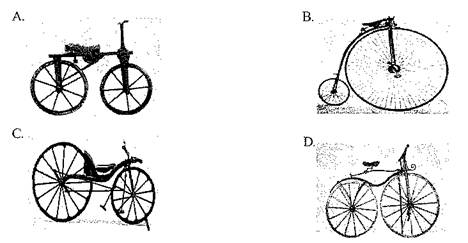Today, bicycles are elegantly simple machines that are common around the world. Many people ride bicycles for recreation, whereas others use them as a means of transportation. The first bicycle was invented in Germany in 1818. Because it was made of wood, it wasn’t very strong nor did it have pedals (脚踏板).Riders moved it by pushing their feet against the ground.
In 1839, Kirkpatrick Macmillan, a Scottish blacksmith, invented a much better bicycle. Macmillan’s machine had iron-covered wheels to keep them from getting worn down. He also used foot-operated levers, similar to pedals, so his bicycle could be ridden at a quick pace. It didn’t look much like the modem bicycle, though, because its back wheel was substantially larger than its front wheel. Although Macmillan’s bicycles could be ridden easily, they were never produced in large numbers.
In 1861, Frenchman Pierre Michaux and his brother Ernest invented a bicycle with an improved pedal mechanism. They called their bicycle a velocipede,but most people called it a “bone shaker” because of the effect of the wood and iron frame. Despite the impolite nickname, the velocipede was a hit. After a few years, the Michaux family was making hundreds of the machines annually, mostly for fun-seeking young people.
Ten years later, James Starley , an English inventor, made several innovations that revolutionized bicycle design. He made the front wheel many times larger than the back wheel, put a gear on the pedals to make the bicycle more efficient,and lightened the wheels by using wire spokes. Although this bicycle was much lighter and less tiring to ride, it was still clumsy, extremely top-heavy,and ridden mostly for entertainment.
It wasn’t until 1874 that the first truly modern bicycle appeared on the scene. Invented by another Englishman, H. J. Lawson, the safety bicycle would look familiar to today’s cyclists. The safety bicycle had equal-sized wheels, which made it easier to ride. Lawson also attached a chain to the pedals to drive the back wheel. By 1893,the safety bicycle had been further improved with air-filled rubber tires, a diamond-shaped frame, and easy braking. With the improvements provided by Lawson
; bicycles became extremely popular and useful for transportation. Today, they are built, used, and enjoyed all over the world.
小题1:This passage was most likely written in order to _____.
| A.compare bicycles used for different purposes |
| B.describe the problems early bicycle makers experienced |
| C.persuade readers to use bicycles for transportation |
| D.tell readers about the early history of the bicycle |
小题2:Macmillan covered the wheels of his bicycle with iron to _____
| A.add weight to the bicycle |
| B.make the bicycle easier to ride |
| C.allow the wheels to last longer |
| D.let the bicycle be more comfortable |
小题3:Which of the following bicycle types was invented by James Starley?

小题4:Which of the following statements is true according to the passage?
| A.Two hundred years ago,bicycles did not exist. |
| B.The first bicycle could be ridden at a very quick pace. |
| C.The Michaux brothers called their bicycle a “bone shaker”. |
| D.Macmillan’s machine had wheels with rubber tires. |
小题5:The information about bicycles in this passage is arranged according to _____.
| A.importance | B.time | C.place | D.Interest |